Scotland Falkland Palace, Noble Palace, Lovely Village
If you are visiting St. Andrews, or you are in Dundee, (it's close to both and not too far from Edinburgh either), or Fife, Falkland Palace is certainly worth a visit, and one of my favourite places. Located right next to the Lomond Hills and the centre of what used to be (and is still referred to as)the Kingdom of Fife as you will find the village of Falkland, and at the heart of the village, Falkland Palace, a masterpiece of Scottish Gothic architecture. The palace is set in a jewel of a Scottish village, Falkland Village, which is truly overflowing with listed ancient and(protected) buildings.
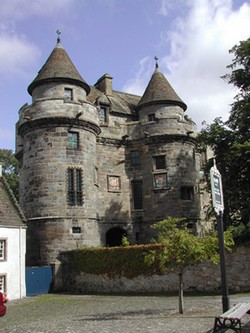
Entrance to Falkland Palace
Mary Queen of Scots is said to have spent the happiest days of her childhood life here, playing in the woods, and knowing how tragic her life was, it's nice to know she had some happy days at least. This is Mary at about thirteen years old.
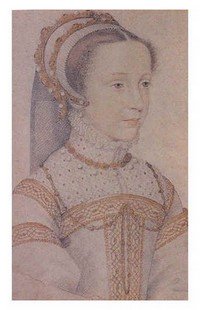
Mary Queen of Scots at 13 years
Falkland Palace most definitely has an aura about it, which words cannot capture, and although photographs can show you its appearance, they certainly can't explain it's personality. You have to go there to experience the feeling that lingers within and around it.
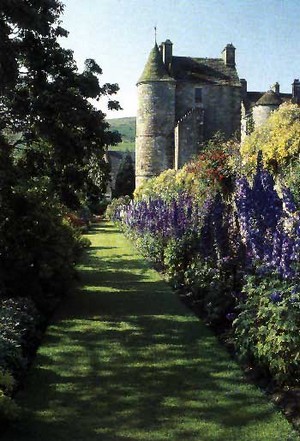
Like Mary Queen of Scots, Falkland Palace has had a turbulent and dark history. The Crown first acquired it from MacDuff of Fife, in the 14th Century. The Duke of Albany imprisoned his nephew, the Duke of Rothesay, in Falkland Palace, where he eventually died from neglect and starvation.
All the Stuart monarchs loved Falkland, and the hunting of
deer and wild boar in the surrounding forests. They also practised falconry here. James V died there, only a day after hearing of the birth of Mary Queen of Scots, with his famous quote "it came in with a lass, and it will gang (go) with a lass". This quote was a reference to the Stewart dynasty, and how it had come to the throne through Marjorie who was the daughter of Robert the Bruce. Sadly, his famous words came true, although not with his daughter Mary, who married a Stewart cousin (Lord Darnley), but with the last monarch of the House of Stewart.
After the Union of the Crowns, Cromwell's army set the palace on fire, and although it was not completely detroyed it fell into ruin. It was not restored until 1887, when John Crichton-Stuart, otherwise known as the 2rd Marquess of Bute, began to restore this beautiful palace.
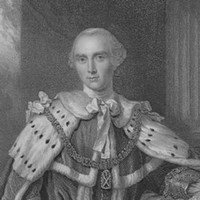
3rd Earl of Bute, 1713-1792 Ancester to the Marquess of Bute served as Prime Minister of Great Britain (1762–1763) under George III
Since 1887, the Crichton Stuarts have been the Keepers of Falkland Palace and in the 1950's they entrusted its care and upkeep to the National Trust for Scotland although they still own it.
Here you can see the Keeper's Bedroom. The "Keeper" was an ancient title bestowed upon the person who took care of one the King's many palaces in his absence, a sort of grand caretaker..
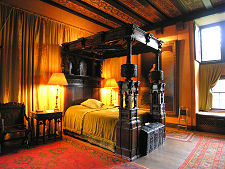
You can definitely get a sense of the people who lived here. This magnificently carved four poster bed probably belonged to James VI
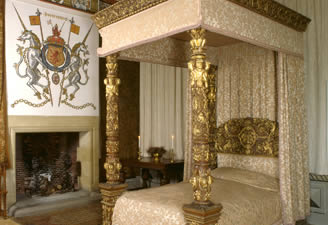
There are also magnificent Flemish tapestries of hunting scenes in the hall and the chapel has a beautifully painted ceiling.
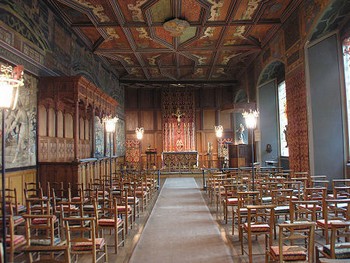
The other amazing feature of Falkland is the tennis court. Not just any old tennis court, it is the oldest royal tennis court in the United Kingdom. It was constructed in 1539 for James V and is still being used..!
I suggest you set aside as long as possible for Falkland village and the palace, because you can get caught up there quite easily! The gardens are delightful also.
You won't want to leave the village either because, although it's quite small and you can explore it on foot, there is so much to see. You are transporting yourself into a bygone time when you walk the streets. There is also an interesting exhibition at the Old Town Hall, called the Royal Burgh of Scotland Exhibition and it explains the history of Falkland. Admission is free.
There are several cozy inns where you can stay or have a meal, among them the Hunting Lodge, on High Street, and the Covenantor Hotel in the square (an 18th century coaching inn).
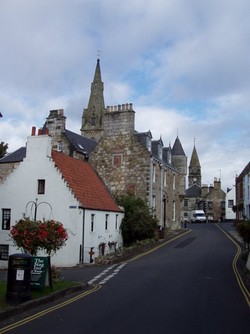
Below is a picture of Falkland Village with the Palace in the background. You see how incongruous the cars look within the medeival setting!
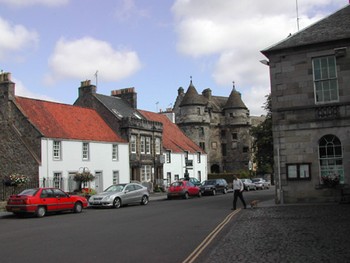
Take the time to explore and discover the history and the atmosphere of Falkland and its palace. You will take away photographs, surely, but more than that you will take with you a lingering feeling of having been a part of something truly special from its long history, maybe something of the feeling Mary Queen of Scots felt when she came here, of being totally removed from the world and its troubles.
Return to Favourite Places
Return to Home Page









